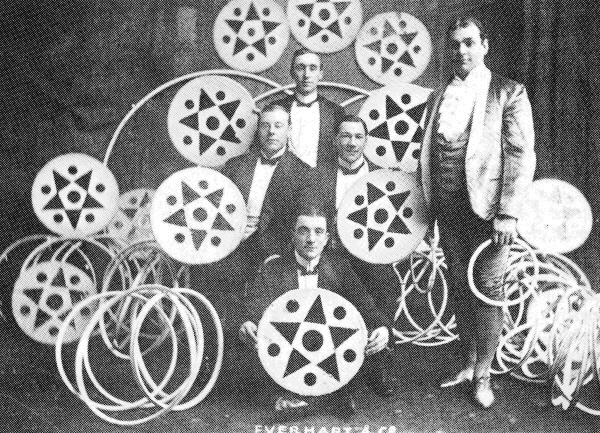|
PEOPLE
Neglected
Arts
Hoop
Rolling Troupes and Others
|
|
One
of the most enjoyable aspects of digging through the archives
of juggling history is
becoming
aware of props and routines that have fallen out of fashion.
Although
some of these arcane bits of juggling may still be practiced
here and there, they are in large part exotic artifacts of
juggling archeology.
Boomerang
hats and plates, spools, gun spinning and Swiss flag swinging
are a few examples that might bring glimmers of recognition.
But
what about juggling soap bubbles using woolen mittens, rug
spinning or fire bowl and chain spinning? Who still practices
"the human pool table" routine with balls tossed
into pockets attached to the performer's suit and rolled and
popped to other pockets?
Although
still around today, the diabolo has seen its heyday. At the
turn of the century, McSovereign of Germany, billed as
"Meister in Diabolospiel," performed a diabolo act
second to none. His spinner climbed a 30-foot string to a
windmill. He bounced it between upright, angled
minitrampolines, had the diabolo climb a string over the
audience to the balcony, and employed a complicated, loop-the-Ioop
device that brought it back to the string after its gyrations.
|
|
One
of the greatest losses in juggling has been the disappearance
of
ensemble theme troupes. More than a group of jugglers, this
old vaudeville standby was a playlet of actors juggling around
a central theme.
|
|
Some
of the most interesting of these ensembles performed hoop
rolling. Every other woodcut from the 1870s and 1880s seems to
show a boy rolIing a barrel hoop along the sidewalk with a
stick. This was the forerunner of a precision effect where
special hoops were rolled and spun and wobbled along the stage
with a dozen different angles and methods of English, giving
them a life of their own. The hoops were often prime players
in the troupe's playlet, taking on personalities of their own.
Of
all the great hoop acts, one stands
out. The Kratons, popular in 1908, set their stage as a small
town with stores, churches, factory, saloon, school and other
buildings. The hoops showed individual
personalities of people in the town.
|
|
Singly,
in pairs or in groups, the hoop people would roll out of a
store and into a house, or leave home for church or the
factory. One hoop came out of the saloon, staggered around,
and landed happily against a lamppost, friend of all
drunkards. When the school bell rang, a passel of kids rushed
out the door in every direction. When the factory whistle
blew, the worker hoops headed for home, some making detours to
the saloon.
Hoop
couples danced. A girlish hoop dropped a hanky and a courting
hoop, with the aid of a pin embedded in the rim, raced along
to pick it up and follow her behind some stage scenery. At the
finale, the lights dimmed, the church bell rang, and families
streamed into the church where a hymn
was sung and the curtains lowered.
|
|

